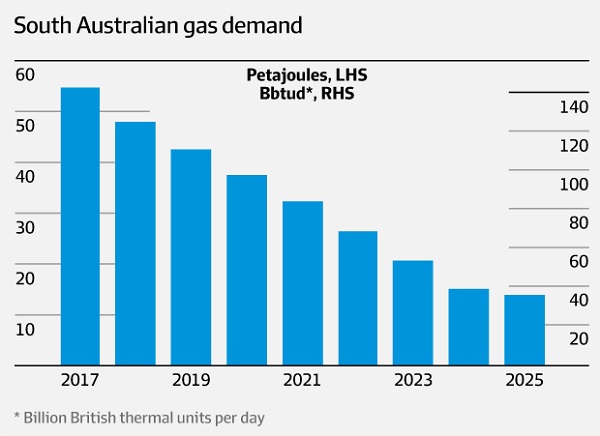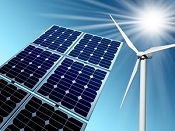It’s the kind of article we expect in RenewEconomy, but this one by Angela Macdonald Smith is in the Australian Financial Review – Future for gas to be cut short by batteries and renewables:
- The conventional wisdom that gas will play an increasingly significant role in electricity supply as the market switches more towards renewables to back up that intermittent supply source, has largely gone out the window.
Now it’s a discussion of how much an opportunity gas has before it gets squeezed out of the mainstream generation market by solar/wind and storage – not on carbon emissions grounds, but on costs.
She’s citing new research by consultancy Wood Mackenzie and GTM Research which suggests that by 2025 the cost of buying and installing batteries will halve, while wind sees a further 15 per cent decline and solar shrinks a further 25 per cent. They see the use of gas falling by 70%:

An attraction for batteries is that wind can be used to charge them in off-peak times for almost nothing.
- Ten years further on, by 2035, the combination of renewables and batteries should be beating not just baseload gas but also gas for peak-period generation.
So:
- The forecast is then that within two decades, gas will be used only for emergency back-up in South Australia.
Scott Morrison was stupid enough to mock SA’s big battery as like the ‘big banana’. He said:
- “30,000 SA households could not get through watching one episode of Australia’s Ninja Warrior with this big battery. So let’s not pretend it is a solution.”
Thus demonstrating that he didn’t understand that the battery was mainly for grid stability. South Australians I’m told reserve the right to mock their own big battery, they don’t appreciate eastern-staters doing it.
The article says the batteries will be different from the current Tesla model, which consists of masses of small batteries connected and stacked in containers. New lithium mines are opening in WA, but I’d bet a different technology will win out. I don’t know whether the new Taiwanese aluminium battery is scalable, but it can charge in one minute, and is fit for more than 10,000 cycles.
Friday’s AFR saw an article by Ben Potter Cheap new energy and CO2 cuts right in front of us – GE. At a Deakin University/Minerals Council conference, Christian Bennett from Ge told the gathering:
GE Global Power Plant Efficiency Analysis shows that the thermal efficiency of Australia’s coal fleet could be lifted from 35 per cent to 39 per cent through a program of upgrades to turbines and boilers and the use of software and data analytics to get more out of them.
Doing so would get 1500 megawatts of new power out of the existing fleet, almost the size of Hazelwood, reducing CO2 by 19 million tonnes. It would mean spending only $57 million-$114 million, which amounts tohat’s no more than $3-$6 a tonne of CO2 saved, or a quarter to a half of the cost of CO2 emissions abatement under the Coalition’s widely denigrated Emissions Reduction Fund scheme.
Potter says:
- Efficiency upgrades to existing coal plant could take their place alongside new grid scale batteries being built by Tesla and Neoen in SA and by Lyon group in SA and Victoria, surging small-scale solar power and batteries and increased use of “demand response” to help shore up the grid.
Under demand response, customers are rewarded for curtailing their power usage and making “behind the meter” batteries, smart pool pumps, airconditioners, and electric vehicle chargers available at times of extreme demand to avoid blackouts. Industry says it can make nearly 700MW available for demand response trials next summer and 1938MW by the summer of 2018-19.
I’ll just remind people that back in 2009 The Greens knocked back Rudd’s climate plans because they would ensure that burning coal continued into the 2030s. Now we seem to be contemplating with equanimity a role for coal past 2050.
That conference was on Monday. On Wednesday, according to Giles Parkinson at RenewEconomy, EnergyAustralia told a conference convened by the AFR “The truth about coal is that it is not cheap”:
- EnergyAustralia, the owner of the ageing Yallourn brown coal generator and one of the big three energy “gen-tailers”, has ridiculed suggestions that a new coal generator would cause energy prices to fall, describing such claims as a “myth”.
The head of EnergyAustralia Catherine Tanna says that coal plants were old legacy technologies; they were not cheap, they would not bring prices down, and were of a different era – a solution that “my grandfather would have built.”
Tanna has said previously that the best way to reduce prices is to ensure more renewables are brought into the market.
Unfortunately Parkinson then goes on to repeat the myth that Queensland generators were gouging the market, which suddenly fell when then energy minister wrote to Stanwell to get them to change their bidding practices.
It’s an inconvenient truth that the letter was sent in June, after Queensland had already had the cheapest prices for about three months.
Business itself is largely asleep at the wheel, as one would expect. Less than 10% of businesses are seriously using renewable energy. The vast majority say renewables are too expensive. Ironically the few who do use renewables cite cheaper cost as the reason.
Here we have markets acting irrationally on the basis of false information, supported in their ignorance by political propaganda from those who actually know better. If they don’t know better they are incompetent. Looking at you Frydenberg and Turnbull.
Meanwhile renewables are breaking out all over.
New South Wales has launched a home batteries guide to deal with the safety problem of lithium-iron batteries.
There are proposals for an $8 billion offshore wind farm for Victorian waters.
Queensland launches “world’s largest” EV fast-charging network from Coolangatta to Cairns.
Queensland eyes a new new transmission line to unlock cheap renewables.
- The Queensland government has unveiled plans to build a new 500km transmission line in the north of the state to unlock barriers to more than 2000MW of large scale wind, solar and hydro projects, and create 5000 jobs.
The chief beneficiaries of the plan will be the proponents of the 1,200MW Kennedy wind and solar park – the largest project of its type in the world – along with other wind and solar farms, and some hydro projects.
Energy minister Mark Bailey says it is clear that it is cheaper to build new wind and solar than new coal plants. Indeed, wind and solar projects are now being signed off at prices – $55-$70/MWh that are well below the current price of wholesale electricity from the state’s coal and gas dependent grid, which is more than $100/MWh.
Bailey also signalled the project would likely mean the end to plans to build a new coal fired power station near Townsville. “If we’re sensible, we will” not build it, he told the Townsville Bulletin.
And still some of our political leaders sprout the need for cheap base load coal. The LNP opposition promises to initiate a coal-fired power station in North Queensland within 100 days of taking office. That’s if the Commonwealth government doesn’t get there first with the Northern Development Fund.

Garnaut
NSW


Matt Canavan on Facebook:
Some silly people thought his job was to represent the people of Queensland.
Facebook link.
In part, power costs are high because the demand for power varies substantially over the day and over the year. The variation means that we have to spend money on the generation and transmission capacity required to meet the peak demands. There are a number of strategies that can be used to reduce the cost of these peaks:
1. Increase the amount of power that is supplied as controlled (off-peak) power. Reduces the size of the peaks but keep in mind that many off peak uses will require the same amount of power over the day whether off peak or on demand power is used.
2. Find users who are willing to be partly or fully shut down for part of the time in return for lower power charges even if it means that this reduces production or increases other costs per unit. (Keep in mind that many businesses are market rather than capacity limited so the cost of planned shutdowns may be negligible. Also keep in mind that heat waves and wind droughts are predictable.)
3. Use grid capacity to minimize the effect of local variation in wind or solar power power or dropping out of a generator. (But keep in mind some energy is lost as power flows along the grid. Roof top solar helps reduce this loss.)
4. Use appropriate generators to supply peaking power. (For peaking power low capital cost is more important than running costs and emissions compared with the best generators that will run most of the time.)
5. Use energy storage to reduce peak generation and transmission requirements. (But keep in mind that energy storage wastes some of the energy fed into the store.)
6. Increase energy efficiency to reduce both peak and average requirements.
I am not convinced that there is any hurry in getting rid of gas fired peaking power. The priority at the moment is to build up renewable use.
We also need to talk more about the advantages of solar towers.
ABC Just in asked ” Does South Australia need two back-up power stations?”
WE are talking about 2 diesel powered gas turbines with a combined capacity of 270MW, or roughly 10 per cent of average demand. This is in addition to the two large battery installations that will go in at the same time. The government claims that
The Government will not say what the precise cost is, but it has budgeted
There are a number of questions that need to be asked given that we are talking about a lot of money for generators that may only run for a few hours per year:
1. Would South Australians be better off putting up with occasional short blackouts instead of having to pay more for power?
2. Are there businesses that would be willing to have their power cut back during peak demand in return for cheaper power..
3. Should these power stations be use to provide a cap on spot prices?
4. Will they stop private providers deciding not to start their generators up when they decide it may not be worthwhile?
5. At what price would the generators make money?
6. Is the proposed operating policy being set up to make private look better than public?
Brian
Just wondering if the suggested 500km transmission line in northern Qld, and/or the Kennedy solar and wind farm, might be eligible for support under that thar “Northern Development Fund”??
Or is it only new coal mines that are ” universally acknowledged to be in need of assistance” ? (adapting Miss J. Austen)
🙁
Origin Energy’s Frank Calabria says ‘no’ to Barnaby Joyce’s clean coal.
John D good questions. My daughter who grew up in Brisbane and lives in Adelaide said the February blackout was trivial. The big one in September, likewise for people in Adelaide, where the power was omly out for 3 or 4 hours.
I think politically Weatherill really had little choice. I think the diesel is only temporary for a new gas station that will perform that function.
I think, however, that reserving it for emergencies is good policy if you want to leave power generation up to the private sector. Ross Garnaut says the government should stay right out of it so as not to confuse the market.
Also, more new wind will be built in SA, and the government initiative may provide the mandatory backup now required.
That’s my best guess.
BTW ACCC boss Rod Sims is saying that states have been concentrating too much on reliability. I’m betting that he’s never lived in SEQ.
Ambigulous, on present form the Turnbull government will do everything possible to avoid making the Palaszczuk government look as though it’s achieving anything before the next election, due next year, but could be sooner.
Brian: Liquid fuels like jet A, diesel or bunker fuel oil make sense for generators that will operate for a very limited time each year and are not next to a gas line that has enough excess capacity. The liquid fuels are easy to store in large steel tanks.
Brian: Some of the questions I asked above were really about the difficulty of mixing public and private, particularly for dealing with rarely reached peaks.
It may have been smarter to have kept it private and used contracts that are based largely on available capacity with only a small charge for power output
I last week returned from visiting my distributor in the Netherlands for a few weeks. This company does a lot of driving around the Netherlands, Germany and France. To reduce the cost of all of that travel they have 5 Teslas and 2 Mitsubishi PHEV’s. To keep those vehicles running they have 400 off 240 watt solar panels on the roof of their warehouse, producing nearly 100 Kw during peak solar periods. That power feeds into the grid so they can use the super charging stations with a clear conscience. I did one trip from Maasland to Dusseldorf which involved 2 charging stops along the way. The first was a Breakfast stop before Dusseldorf, and the second was on the way back for afternoon tea. These cars have phenomenal acceleration and road holding, and this was the first time I have travelled at 200 kph on a road in a vehicle without jet engines attached.
It can be done and is extremely cost effective, its just a matter of working the numbers properly. Yes there are subsidies and incentives, but these are reducing in Europe with time.
While I was away we had the high bay sodium vapour lamps in the factory replaced with the LED equivalents. The old lights were fading in effectiveness and their transformers when warming made a hell of a racket. The new lights are instantly on and ridiculously bright, I’m going to have to find a way to turn them down. And the power consumption has dropped away to insignificant, I don’t know why I did not do it sooner.
South Australia’s power problems will be helped by the shutting down of he car industry and growth of solar PV.
I think it doesn’t except politically.
I’m still to post on the organisational changes recommended by Finkel. However, he does start with the premise that states are responsible for the electricity system, probably by virtue of the constitution. Certainly, by tradition. It’s just that they ceded responsibility from about 1996 on until I think it was 2009 when the the NEM was fully operational. The gods were privatisation, competition, vertical layering of functions and a national operator in what was supposed to be a single rational market.
Probably started by Keating and finished by Rudd.
SA government ended up being a spectator, but was still being held accountable by the voters, and being hectored and denigrated by the Feds in a huge exercise of politics and blame-shifting.
It’s no way to run a railroad, so suboptimal outcomes are pretty much inevitable..
Bilb, that’s more than a little inspiring about EVs. Thanks also for the photograph.
Next CC will be an update mainly on science and stuff, then I hope to get get back to the practical side.